
Literally translated as “Korean Beef”, Hanwoo is a domesticated breed of cattle in Korea that has historically been raised as a workhorse on farms.
It has a unique genetic composition as a purebred group native to Korea without any foreign breeds or crossbreeding. The native Hanwoo currently preserved is divided into bull (hwang-so), striped cow (chik-so), black cow (heuk-woo), and white cow (baek-woo) according to their coat color.

Hanwoo in Korea is not raised on a large scale; instead, each region maintains a carefully managed number of animals. Every Hanwoo farm meticulously manages each animal to ensure the highest standards of safety and quality. Additionally, farmers can quickly quarantine and vaccinate individual cattle in the event of a disease outbreak, allowing them to promptly address injuries or health concerns.

Hanwoo was selected by the Korean Ministry of Culture, Sports and Tourism as one of the “Top 100 National Cultural Symbols,” a program that seeks to identify the ethno-cultural characteristics of the Korean people and the essence of national culture. This is because Hanwoo has been treated as a family member before livestock in Korea since ancient times and is deeply rooted in the lives of farmers. Hanwoo is also the first item on a farmer’s list of possessions, symbolizing the abundance or cornucopia of a feast. It is also widely known as a representative food that is synonymous with the Shintobuli belief, which means, “Only the agricultural products from one’s homeland are suitable for the body”.
Hanwoo in Korean History

With the development and expansion of agricultural machinery and the growth of the Korean economy, their usefulness as workhorses has become almost obsolete. Instead, they have been transformed into meat cattle that provide the Korean people with high-quality beef.
Hanwoo used to be a variety of black, yellow, and speckled cattle. Unfortunately, during the Japanese occupation, the diversity of Hanwoo was wiped out and shipped to Japan, China, and Russia, leaving only the tan Hanwoo.
After Korea’s liberation from Japanese colonial rule, efforts to improve the quality of Hanwoo meat began in the 1960s and were accelerated by the establishment of the Korean Breeders Association in 1969. By 2023, quality has advanced to the point where 74.7% of the meat is Grade 1 or better.
TOP














